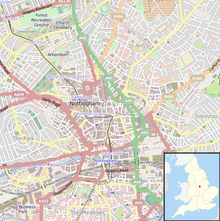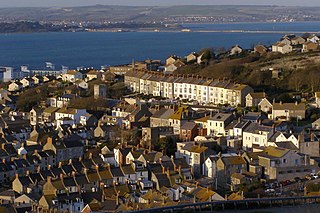
Fortuneswell is a village in Underhill on the Isle of Portland, in Dorset, England. It lies on steeply sloping land on the northern edge of the island, known as Underhill, where Chesil Beach connects the island to the mainland. Adjoining Fortuneswell are Chiswell to the west and Castletown to the north. Fortuneswell occupies the steeper land above sea level, whereas Chiswell and Castletown occupy flat land close to sea level, next to Chesil Beach and Portland Harbour respectively. Fortuneswell has a main shopping street, and along with Easton, is the main hub of the island's activities.

Castle Cary is a market town and civil parish in south Somerset, England, 5 miles (8 km) north west of Wincanton and 8 miles (12.9 km) south of Shepton Mallet, at the foot of Lodge Hill and on the River Cary, a tributary of the Parrett.

Blaise Castle is a folly built in 1766 near Henbury in Bristol, England. The castle sits within the Blaise Castle Estate, which also includes Blaise Castle House, a Grade II* listed 18th-century mansion house. The folly castle is also Grade II* listed and ancillary buildings including the orangery and dairy also have listings. Along with Blaise Hamlet, a group of nine small cottages around a green built in 1811 for retired employees, and various subsidiary buildings, the parkland is listed Grade II* on the Register of Historic Parks and Gardens of special historic interest in England.

Richmond Green is a recreation area near the centre of Richmond, a town of about 20,000 inhabitants situated in south-west London. Owned by the Crown Estate, it is leased to the London Borough of Richmond upon Thames. The Green, which has been described as "one of the most beautiful urban greens surviving anywhere in England", is roughly square in shape and its open grassland, framed with broadleaf trees, extends to roughly twelve acres. On the north-east side there is also a smaller open space called Little Green. Richmond Green and Little Green are overlooked by a mixture of period townhouses, historic buildings and municipal and commercial establishments including the Richmond Lending Library and Richmond Theatre.

Heytesbury is a village and a civil parish in Wiltshire, England. The village lies on the north bank of the Wylye, about 3+1⁄2 miles (5.6 km) southeast of the town of Warminster.
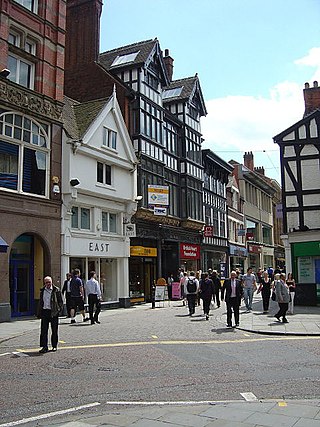
Bridlesmith Gate is a pedestrianised shopping street in the city centre of Nottingham, England. It is located between Middle Pavement and Victoria Street. St. Peter's Gate and Bottle Lane stem off it along with Byard Lane.

St Wilfrid's Church is in Main Street, Melling, Lancashire, England. It is recorded in the National Heritage List for England as a designated Grade I listed building, and is an active Anglican church in the united benefice of East Lonsdale, the deanery of Tunstall, the archdeaconry of Lancaster and the diocese of Blackburn. Its benefice is combined with those of St Peter, Leck, St John the Baptist, Tunstall, St James the Less, Tatham, the Good Shepherd, Lowgill, and Holy Trinity, Wray.

High Pavement is a street in Nottingham in Nottinghamshire, England. It is one of the earliest streets in the city, and most of its buildings are listed.

Castle Gate Congregational Centre is in Nottingham. It is a Grade II listed building.
Cockermouth is a civil parish and a town in the Cumberland unitary authority area of Cumbria, England. It contains 105 listed buildings that are recorded in the National Heritage List for England. Of these, six are listed at Grade I, the highest of the three grades, seven are at Grade II*, the middle grade, and the others are at Grade II, the lowest grade. Cockermouth is a market town at the confluence of the Rivers Derwent and Cocker, and bridges crossing these rivers are listed. The oldest surviving building is Cockermouth Castle, parts of which are in ruins, and parts are inhabited; these are all listed. Historically the town's industries have been milling and brewing. Former mills that have been adapted for other uses, and part of a brewery are listed. Most of the other listed buildings are houses, cottages and associated structures. A variety of other buildings are listed, including schools, churches, hotels, public houses, a former hospice, a milestone, a former court house, a former bank, a statue, and the town hall.
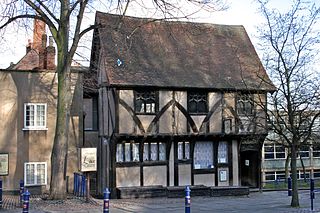
Severn's Building is a Grade II listed building dating from the 15th century in the English city of Nottingham. Originally located in the city's Middle Pavement, it was relocated to the junction of Castle Road and Castle Gate around 1970.

Newdigate House is a Grade II* listed building on Castle Gate, Nottingham.

Hounds Gate is an historic street in the centre of the city of Nottingham between St Peter’s Square and Castle Road.
Tickhill is a civil parish in the metropolitan borough of Doncaster, South Yorkshire, England. The parish contains 121 listed buildings that are recorded in the National Heritage List for England. Of these, one is listed at Grade I, the highest of the three grades, four at Grade II*, the middle grade, and the others are at Grade II, the lowest grade. The parish contains the town of Tickhill and the surrounding countryside. The parish church, St Mary's Church, is listed at Grade I, and the Grade II* listed buildings are an Augustinian friary converted for domestic use, St Leonard's Hospital, later used as a parish room, a house built in the grounds of Tickhill Castle, and Lindrick House from the early 18th century. Most of the other listed buildings are houses, cottages, and associated structures, shops and offices, farmhouses and farm buildings. The rest include the original buttercross and its later replacement, a bridge, a mill, chapels, and a milestone.

Willoughby House is a Grade II* listed building on Low Pavement in Nottingham.
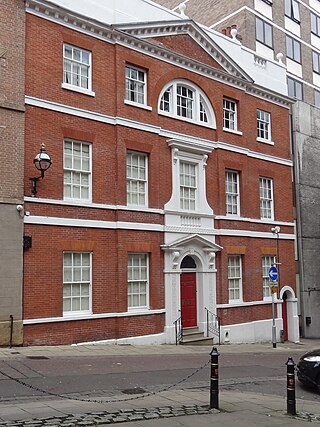
Sheriff House is a Grade II* listed building on St James’ Street Nottingham.

19, Castle Gate, also known as Stanford House, is an 18th-century Grade II* listed building on the corner of Castle Gate and Stanford Street, in the English city of Nottingham. It should not be confused with 6, Stanford Street, a 19th-century grade II listed former warehouse, which is also known as Stanford House.
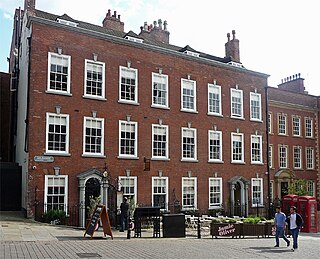
24–26 Low Pavement are a pair of Grade II* listed buildings on Low Pavement, Nottingham.

6, Stanford Street, also known as Stanford House, is a 19th century grade II listed former warehouse on Stanford Street in the English city of Nottingham. It should not be confused with 19, Castle Gate, an 18th century grade II* listed house on the corner of Stanford Street and Castle Gate, which is also known as Stanford House.


